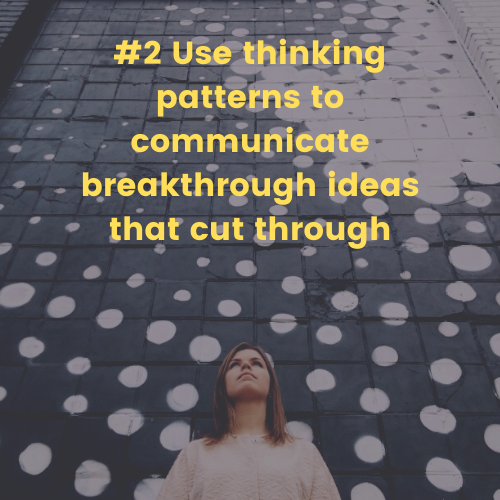#1 – Turbo charge
your communication using your critical thinking skills
Great communicators are not born. They are made.
When I first joined McKinsey as a communication specialist, I was astounded at how quickly consultants came up with rigorous ways to think about new issues.
Over time I came to see how they did it and wanted to share one related strategy that will help you with your communication.
Thinking top down boosts your impact enormously while also providing a useful framework for doing justice to your analysis when communicating.
Here are three ideas to help you put that into practice:
- Understand what top-down thinking is about
- Get into the helicopter first
- Make like a porpoise
I'll run them through in more detail one by one.
Understand what top-down thinking is about
Top-down thinking is about identifying the things that matter most before either deciding what problem to solve or building the supporting case for your point.
In practice, it’s a bit like when you go to an experienced tailor: they don’t tally up each measurement and then look at a chart to know that you are a size 42 regular.
They take a quick look at you and have a hunch that you look like a 42 regular and then test that hypothesis by taking out their measuring tape to check that they are right.
If their measurements disprove their hunch, they adjust their thinking to conclude that perhaps you are a size 40 and proceed accordingly.
In problem solving, this means thinking through the roadmap before digging into any particular aspect of the analysis.
In communication, this works largely the same way.
With experience, we can identify the communication pattern and then test it using a set of principles to check that our message and supporting points are accurate and will cut through.
We outline both our favourite seven storyline patterns and a useful test in our short and practical book, The So What Strategy.
Top-down and bottom-up strategies complement each other but starting with the top magnifies our impact and saves us significant amounts of time.
So, let’s look at how you do that.
Get into the helicopter first
As with many things, the idea of thinking top down isn’t that hard.
Doing it, however, is not as straightforward unless you have a process to follow.
Here is how I think about it when preparing a piece of communication.
When thinking through my strategy before I draft anything, I focus on absolutely nailing two things: my purpose and my
audience.
This is information that doesn’t appear inside my communication, but shapes it.
In going through this process, there is one critical question that I always ask: What would they need to know to agree with me, or do what I need them to do?
I then reach for one of our seven So What Strategy storyline patterns to see whether one of them fits my situation, or whether I need to start my thinking from scratch.
This brings me to my next point.
Make like a porpoise
Have you seen the way a porpoise bobs up and down as it swims?
This is a useful image for me when I think about how I make sure I take full advantage of both top down and bottom up
thinking when I prepare my communication.
As discussed above, I first sort out my top-level messaging, ideally using one of our patterns to fast track this process wherever possible.
I then iterate up and down through the hierarchy of my thinking until I am confident that all the ideas I need to communicate have a logical place in my storyline.
This played out real time in today’s coaching session.
I worked with a team to prepare a short but contentious email outlining some changes to their priorities that partner organisations needed to know about.
We started thinking through our strategy, mapped out our high-level messaging and then as we worked our way toward the end, asked ourselves whether each point was in the right place.
To do that, we assessed the links between our ideas and the inferences we were drawing at each stage.
We checked that the introduction would draw the audience into our main point quickly, that the ideas that supported that main point are organised to be MECE (mutually exclusive and cover everything).
We also double checked that the ideas on the page achieved our initial purpose and addressed the concerns of the most important audience members.
The team then communicated the message top down.
They began with a short introduction and followed with the main idea and then the right depth of carefully mapped ideas to support that idea.
They made sure their audience ‘got' the big picture quickly and followed the argument step by step.
I hope that gives you some useful ways to think about how your critical thinking skills can turbo charge your communication.
I look forward to sharing Tip 2 with you, which offers more ideas for using thinking patterns to communicate breakthrough ideas that cut through.
You can navigate to it straight away using the menu at the bottom of this page.
Talk soon,
Davina
Next step - Learn more about the So What Strategy
This short and powerful book provides a go-to strategy to help you clarify your thinking so you can communicate complex messages clearly. The So What Strategy framework has been tested on thousands of professionals and is proven to be suited to the vast majority of professional communication settings.

This Tip was prepared by Davina Stanley, founder of The Clarity First Program and author of The So What Strategy.
Davina has been helping experts communicate complex ideas for more than 20 years.
She began this work when a Communication specialist at McKinsey & Company and has since helped experts of all kinds strengthen their communication skills.
She lives in Sydney Australia, having previously lived and worked in Hong Kong, Tokyo and New York.




